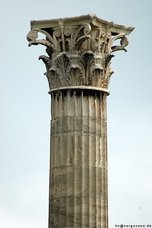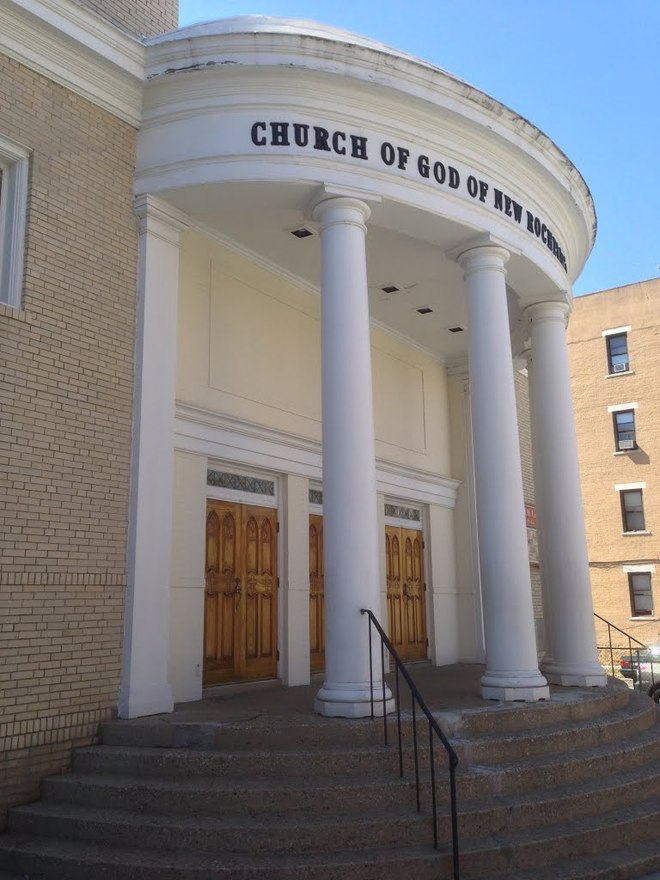architectus
simple.wikipedia.org
Our traditional understanding of church architecture might be as is depicted above. Or, it might be something simpler and more conservative. My informed opinion is that many of our Pentecostal churches do not look like this, as our movement began on the fringes of society and has slowly worked its way to prominence. For this cause, my emphasis will not be on the architectural layout of churches across time. Rather, our focus here will be on Pentecostal churches buildings in North America.
It should be duly noted that, many of the buildings that now house our churches have been reclaimed and repurposed. I will give a few examples:
It should be duly noted that, many of the buildings that now house our churches have been reclaimed and repurposed. I will give a few examples:
www.static.panoramio.com

This happens to be my own church, in New Rochelle, NY. As charismatic as the body inside is, the church edifice does not mirror this charisma. The church was formerly a Christian Science building, built circa 1941. What is now the main sanctuary is seething with design from the Corinthian architectural order.
Oddly enough, many seem to be oblivious to the fact that what they are worshiping in does indeed affect the manner in which they worship. The ideology seems to be that 'I can worship anywhere'. It is suggested that the truly spiritual can praise the name of the Lord in any location. True, what about when the 'spiritual' must choose a location, how do they select?
Oddly enough, many seem to be oblivious to the fact that what they are worshiping in does indeed affect the manner in which they worship. The ideology seems to be that 'I can worship anywhere'. It is suggested that the truly spiritual can praise the name of the Lord in any location. True, what about when the 'spiritual' must choose a location, how do they select?
McNamara, although possessing a focus on the Catholic Church, provides an excellent foundation for the theology of church architecture. He argues that church architecture must be like Christ's body, bearing the meaning that God intends. In my own estimation, the edifice must point upward. In our Western understanding, Heaven and the heavens are all northern. This is appropriately reflected in some of our architecture. Additionally, the building is a 'foretaste' of the glory of God. As we enter into His Courts, we are aware that this is not everything that God has promised to us. Yet, we know that this is a divine foreshadowing of that which is to come. The stained-glass windows mirror the bejeweled streets of glory. The sloping ceilings and steeple remind us to point our focus heavenward. In essence, the building is a message.
Some argue that one cannot make a building sacred. Rather, their stipulation is, that one creates an atmosphere architecturally that fosters spirituality. Uwe Michael Lang, a student of architectural theology, professor, and priest asserts that the Catholic tradition has a deeper understanding of the sacredness of buildings in which we worship. These places are sacred because they are houses for the sacraments, like the Eucharist.
Some argue that one cannot make a building sacred. Rather, their stipulation is, that one creates an atmosphere architecturally that fosters spirituality. Uwe Michael Lang, a student of architectural theology, professor, and priest asserts that the Catholic tradition has a deeper understanding of the sacredness of buildings in which we worship. These places are sacred because they are houses for the sacraments, like the Eucharist.
Your browser does not support viewing this document. Click here to download the document.
What if our charismatic leaders thought about the buildings they own in this manner? I believe that in many ways we are overly concerned with an idolatry that just isn't present. Moreover, in many of our churches, we are already idolatrous in how we manipulate decisions to favor our perspectives on what the physical building should look like.
Dr. McNamara also gives an extensive discussion on the importance of church architecture in the following video.
Dr. McNamara also gives an extensive discussion on the importance of church architecture in the following video.
It's odd to see that in my research, not a lot of study has been conducted on Evangelical church buildings. My inference is that this is because Evangelical churches do not yet have a particular style. When I say Evangelical here, I mean Pentecostal-charismatic. We are housed everywhere, and our movement is still too young and too blossoming for us to have developed a particular architectural style. Moreover, we have spent first fifty-plus years focused on the 'rapture'. Why focus on building structure if the most important thing is to get as many souls as quickly as possible. While I do not support disillusionment reading the Eschaton, I do believe that we should 'come back to our senses', and also consider the things that may have been affecting us this entire time without our full recognition.I believe that as our movement is growing into maturity, we can now do away with the clapboard church mentality and move into something a bit more sophisticated. By this, I mean that we need to mature in our concepts and thinking.
It would be simply uncouth to discuss the architecture of churches and fail to mention the historic polarity between the Catholic and Protestant churches. English history presents this in a clear manner for us, and an analysis thereof would enlighten one's mind on such a topic. Nevertheless, our discussion here is not dealing with any recap of the history of English feuding, but rather church architecture as it relates to our tradition.
It would be simply uncouth to discuss the architecture of churches and fail to mention the historic polarity between the Catholic and Protestant churches. English history presents this in a clear manner for us, and an analysis thereof would enlighten one's mind on such a topic. Nevertheless, our discussion here is not dealing with any recap of the history of English feuding, but rather church architecture as it relates to our tradition.
